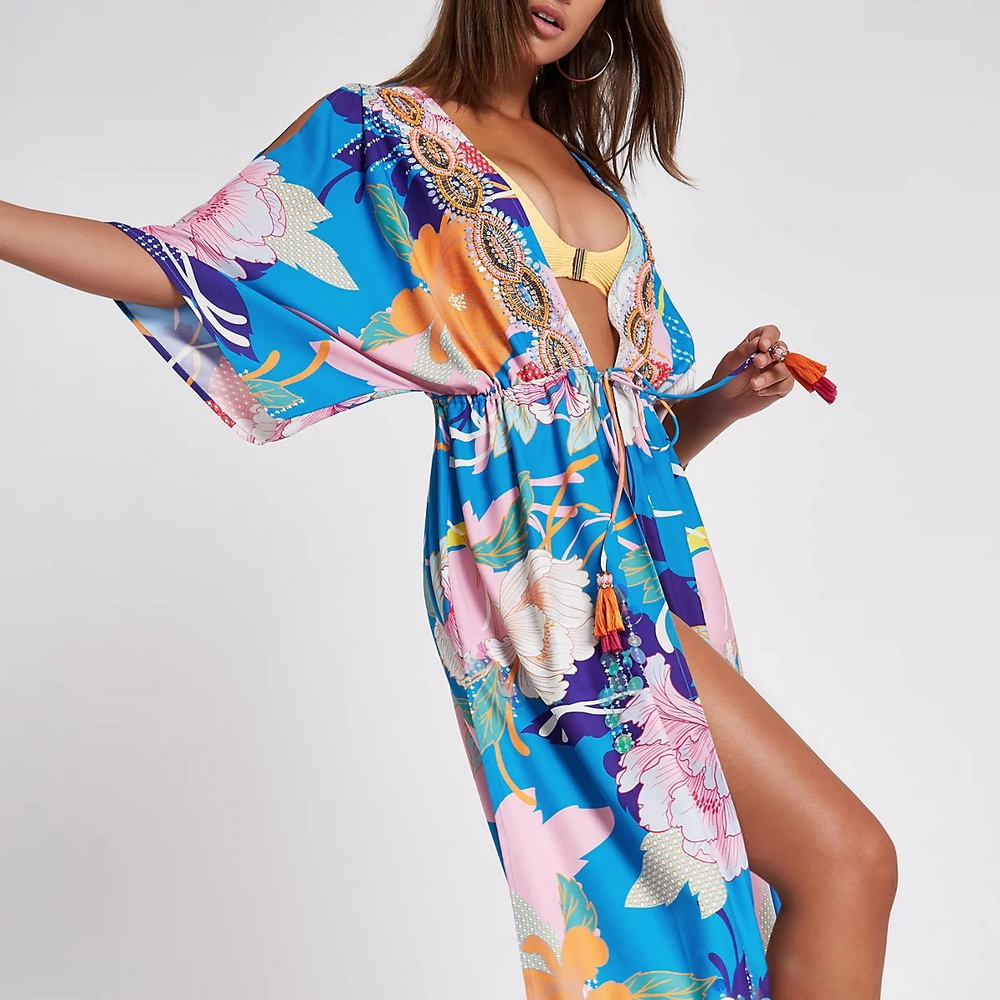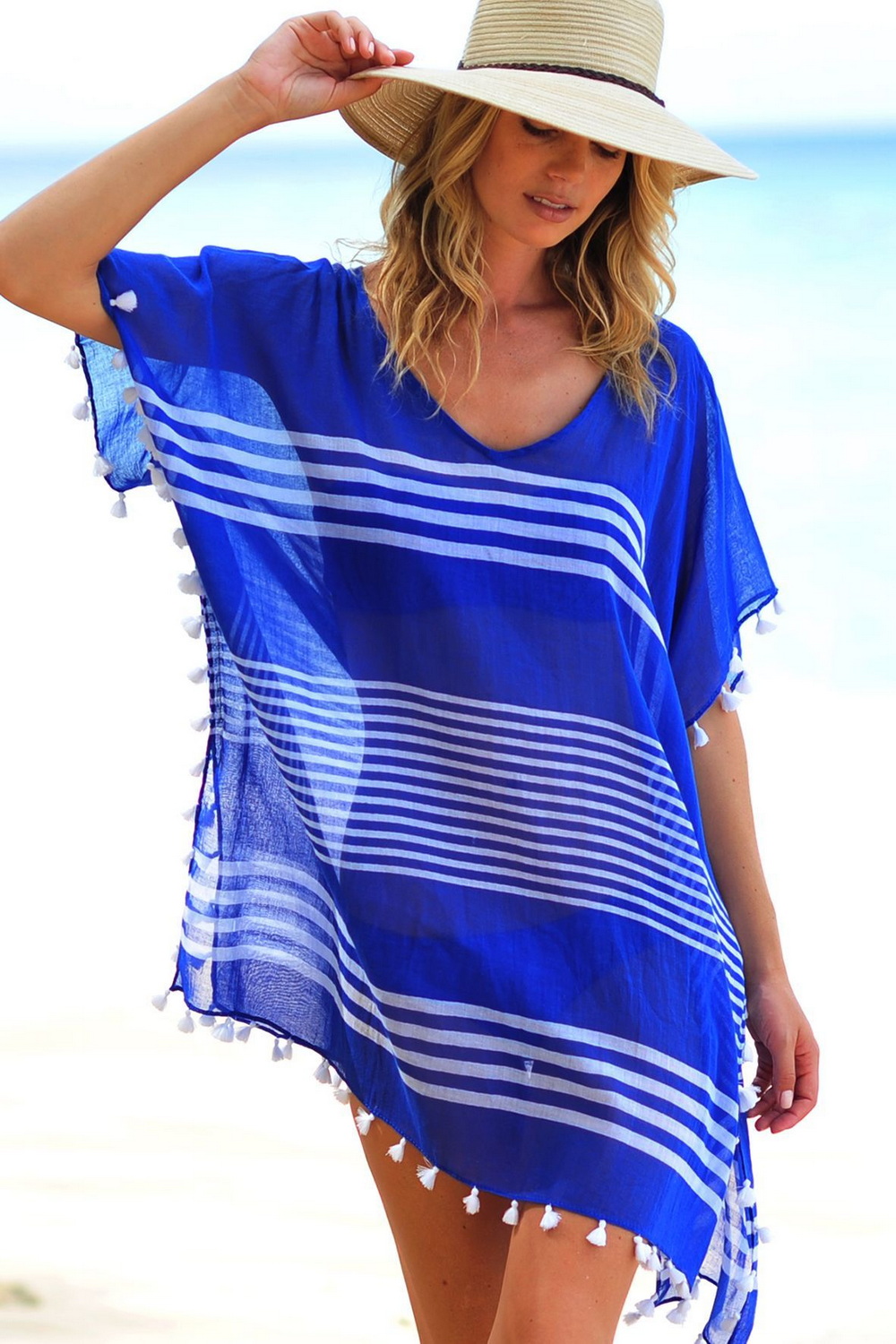Content Menu
● What Is a Swimsuit Cover Up?
>> Types of Swimsuit Cover-Ups
>> Benefits of Wearing a Cover-Up in the Water
● Can You Wear a Swimsuit Cover Up in the Water?
● Why People Wear Bathing Suits in Water
● Fabrics Suitable for Water-Ready Cover Ups
● Tips for Choosing the Right Cover-Up
● 1. Check the Fabric
● 2. Consider the Fit
● 3. Style Versatility
● 4. Color and Design
● OEM Production of Water-Safe Swimsuit Cover Ups
● Expert Tips: Making Cover Ups That Can Go in the Water
● Why Brands Should Offer Water-Compatible Cover Ups
● Sustainable and Eco-Friendly Cover Up Manufacturing
● Styling Ideas: How to Wear Water-Ready Cover Ups
● How to Order OEM Swimsuit Cover Ups
● Conclusion
● FAQs About Wearing Swimsuit Cover Ups in Water
>> 1. Can you wear a swimsuit cover up in the water safely?
>> 2. Which materials are not suitable for water?
>> 3. Do cover ups shrink after swimming?
>> 4. How should I wash water-compatible cover ups?
>> 5. Can OEM manufacturers make customized water-safe designs?
Can you wear a swimsuit cover up in the water? This question often arises when swimmers or beach lovers want to transition smoothly from lounging by the pool to taking a dip without changing outfits. Understanding the differences between swim covers designed for style and those suitable for actual swimming is essential.
As a professional swimsuit manufacturer and OEM supplier in China, our factory specializes in creating stylish, functional, and water-friendly swimsuit cover ups for international brands and wholesalers. This article explains what materials work best, how to design water-ready cover ups, and why OEM customization can elevate your brand.

What Is a Swimsuit Cover Up?
A swimsuit cover up is a lightweight garment worn over a swimsuit to provide modesty, sun protection, or style. Common types include kaftans, sarongs, tunics, and mesh dresses. Many people wonder, *can you wear a swimsuit cover up in the water?* The answer depends on the fabric composition and design purpose.
Traditional cover ups use cotton, rayon, or chiffon—excellent for breathability but not for submersion. However, high-tech fabrics such as nylon blends, spandex, and polyester mesh allow for limited water contact, making them suitable for swimming-friendly designs.
Types of Swimsuit Cover-Ups
1. Dresses: Lightweight and flowy, these are perfect for a beach day. They can be easily slipped on over a swimsuit and are often made from quick-drying materials.
2. Kimonos: These are stylish and provide a bit more coverage. They can be worn open or tied, making them versatile for different body types.
3. Sarongs: A classic choice, sarongs can be tied in various ways, allowing for customization in coverage and style.
4. Shorts and Pants: These are practical options that can be paired with a tank top or a bikini top for a casual look.
Benefits of Wearing a Cover-Up in the Water
1. Sun Protection: Cover-ups can shield your skin from harmful UV rays, especially during peak sun hours. This is particularly important for those with sensitive skin or a history of sunburn.
2. Modesty: For individuals who prefer more coverage, wearing a cover-up can provide a sense of comfort and confidence while swimming.
3. Style: A stylish cover-up can enhance your beach or poolside look, allowing you to transition from water activities to socializing effortlessly.

Can You Wear a Swimsuit Cover Up in the Water?
Can you wear a swimsuit cover up in the water? The general rule is *yes*, but only with materials engineered for aquatic use. Below are key factors to consider:
- Fabric Type: Polyester, nylon, and spandex blends mimic swimwear fabrics, making them fast-drying and chlorine-resistant.
- Design Construction: Seamless or flat-lock stitching prevents irritation during swimming.
- Color Retention: Water-safe dyes ensure long-lasting vibrancy even after repeated exposure.
- Functionality: Designs with elastic or adjustable fittings stay secure underwater.
So, can you wear a swimsuit cover up in the water designed from these materials? Absolutely — they're comfortable, functional, and aesthetically pleasing for both beachwear and active use.
Why People Wear Bathing Suits in Water
People wear bathing suits in water for several reasons, primarily focused on protection, comfort, and personal choice.
1. Protection: One of the main reasons is to protect the skin from harmful UV rays. Many individuals prefer to cover up to shield their skin from sunburn, especially during prolonged exposure to sunlight. Additionally, some may wear cover-ups to conceal scars or imperfections they are not comfortable displaying.
2. Modesty: For many, wearing a swimsuit cover-up is a way to feel more secure and modest while swimming. This is particularly relevant for those who may feel self-conscious about their bodies or have cultural or religious beliefs that necessitate more coverage.
3. Comfort: Comfort is a significant factor; many people find that wearing a cover-up allows them to feel more at ease in the water. The right cover-up can provide a sense of security and confidence, making the swimming experience more enjoyable.
4. Cultural and Religious Considerations: In some cultures, wearing a swimsuit may not be acceptable, leading individuals to opt for cover-ups that align with their beliefs while still allowing them to enjoy water activities.
Overall, the choice to wear a bathing suit in the water is influenced by a combination of personal comfort, cultural norms, and the desire for protection from the elements.

Fabrics Suitable for Water-Ready Cover Ups
The choice of fabric answers the critical question: *can you wear a swimsuit cover up in the water?* Here are top-performing materials ideal for OEM and ODM production:
- Polyester Mesh: Lightweight, flexible, and quick-drying. Perfect for transparent yet practical designs.
- Nylon-Spandex Blend: Offers excellent elasticity and resistance to saltwater and chlorine.
- Lycra Fabric: Retains shape exceptionally well, ideal for active swimmers.
- Microfiber: Soft touch and moisture-wicking capabilities.
If you aim to produce cover ups that customers can wear in water confidently, sourcing performance-grade fabrics is crucial. Our factory partners with certified suppliers to ensure all materials meet durability and comfort standards.
Tips for Choosing the Right Cover-Up
When selecting a swimsuit cover-up for water activities, consider the following tips:
1. Check the Fabric
Look for materials that are lightweight, breathable, and quick-drying. Fabrics like nylon, polyester, and spandex are excellent choices.
2. Consider the Fit
Choose a cover-up that fits well without being too tight or too loose. A snug fit will prevent the cover-up from billowing in the water.
3. Style Versatility
Select a cover-up that can be worn in multiple ways. For example, a sarong can be tied in various styles, while a kimono can be worn open or closed.
4. Color and Design
Choose colors and patterns that reflect your personal style. Bright colors and fun prints can add a playful touch to your beach attire.

OEM Production of Water-Safe Swimsuit Cover Ups
As a Chinese swimwear OEM manufacturer, we help global brands answer customer needs around questions like *can you wear a swimsuit cover up in the water?* by producing fully customizable designs.
Our OEM Advantages include:
- Professional design team developing fashion-forward, aquatic-friendly cover ups.
- Fabric sourcing optimized for colorfastness, elasticity, and UV resistance.
- Custom logo printing, labeling, and packaging for international orders.
- Flexible small-batch and mass-production options.
- Strict quality control for export standards compliance (EU, US, AU).
Expert Tips: Making Cover Ups That Can Go in the Water
Can you wear a swimsuit cover up in the water? With the right approach, absolutely. To design functional water-ready cover ups:
1. Choose stretch fabric like spandex blends that dry fast.
2. Avoid 100% cotton, which becomes heavy and saggy when wet.
3. Use flat seams or bonded edges for comfort underwater.
4. Offer styles like bodycon mesh dresses or sporty wraps.
5. Apply UV-protection coatings for outdoor performance.
Implementing these principles helps brands deliver cover ups that blend elegance with aquatic utility.
Why Brands Should Offer Water-Compatible Cover Ups
Market trends indicate that consumers increasingly seek multi-purpose swimwear. Providing products that effortlessly transition from lounging to swimming adds convenience and value.
So when shoppers ask: *can you wear a swimsuit cover up in the water?*, your brand can confidently offer beautiful, water-ready options—especially when produced by an experienced Chinese OEM factory.
Key Benefits for Brands:
- Enhanced customer satisfaction through versatile designs.
- Reduced product return rates due to clear water-suitability labeling.
- Increased brand loyalty with exclusive, practical collections.
We support brands through custom fabric testing, prototype sampling, and mass production to align performance with your market needs.

Sustainable and Eco-Friendly Cover Up Manufacturing
Today, being stylish is not enough—sustainability matters. Eco-conscious consumers ask not just *can you wear a swimsuit cover up in the water*, but also *is it eco-friendly?*
Our factory uses recycled nylon, RPET polyester, and biodegradable fabrics. These materials perform excellently in water while reducing environmental impact.
We can create water-compatible cover ups that meet your sustainability goals without sacrificing comfort or design appeal.
Styling Ideas: How to Wear Water-Ready Cover Ups
Here are some ways to style water-safe cover ups:
- Beach-to-bar look: A quick-dry mesh kimono over your swimsuit.
- Pool party vibe: Spandex mini dress cover up that can go straight into the pool.
- Active day: Lycra tunic top paired with swim leggings for paddleboarding or kayaking.
Yes—*can you wear a swimsuit cover up in the water?* You can, and these styling ideas prove it's both fashionable and functional.
How to Order OEM Swimsuit Cover Ups
Collaborate with our experienced OEM swimwear production team to design and manufacture cover ups that perform beautifully in and out of water.
From pattern design to custom branding, we handle every process transparently to help international clients build strong swimwear collections.
Contact us today to discuss your OEM swimsuit cover up needs and receive a free sample quotation.
Conclusion
So, can you wear a swimsuit cover up in the water? The definitive answer is yes—if made from the right materials and constructed professionally.
Whether you're a brand owner, wholesaler, or distributor, partnering with a Chinese swimsuit manufacturer that understands both fashion and functionality is essential.
Our team designs and produces custom water-friendly cover ups tailored for global swimwear markets. Combine innovation, quality, and versatility in your next collection.
FAQs About Wearing Swimsuit Cover Ups in Water
1. Can you wear a swimsuit cover up in the water safely?
Yes. Water-safe fabrics like nylon, spandex, and polyester allow for comfortable and safe use underwater without fading or stretching.
2. Which materials are not suitable for water?
Avoid pure cotton or rayon cover ups, as they absorb water, become heavy, and lose shape when wet.
3. Do cover ups shrink after swimming?
High-quality synthetic materials will not shrink, especially if properly pre-treated and chlorine-tested during manufacturing.
4. How should I wash water-compatible cover ups?
Hand wash with mild detergent, rinse thoroughly, and air dry. Avoid bleach or high-heat dryers.
5. Can OEM manufacturers make customized water-safe designs?
Yes. Our Chinese factory offers full OEM customization—from fabric selection to branding and packaging—ideal for international swimwear brands.




































































